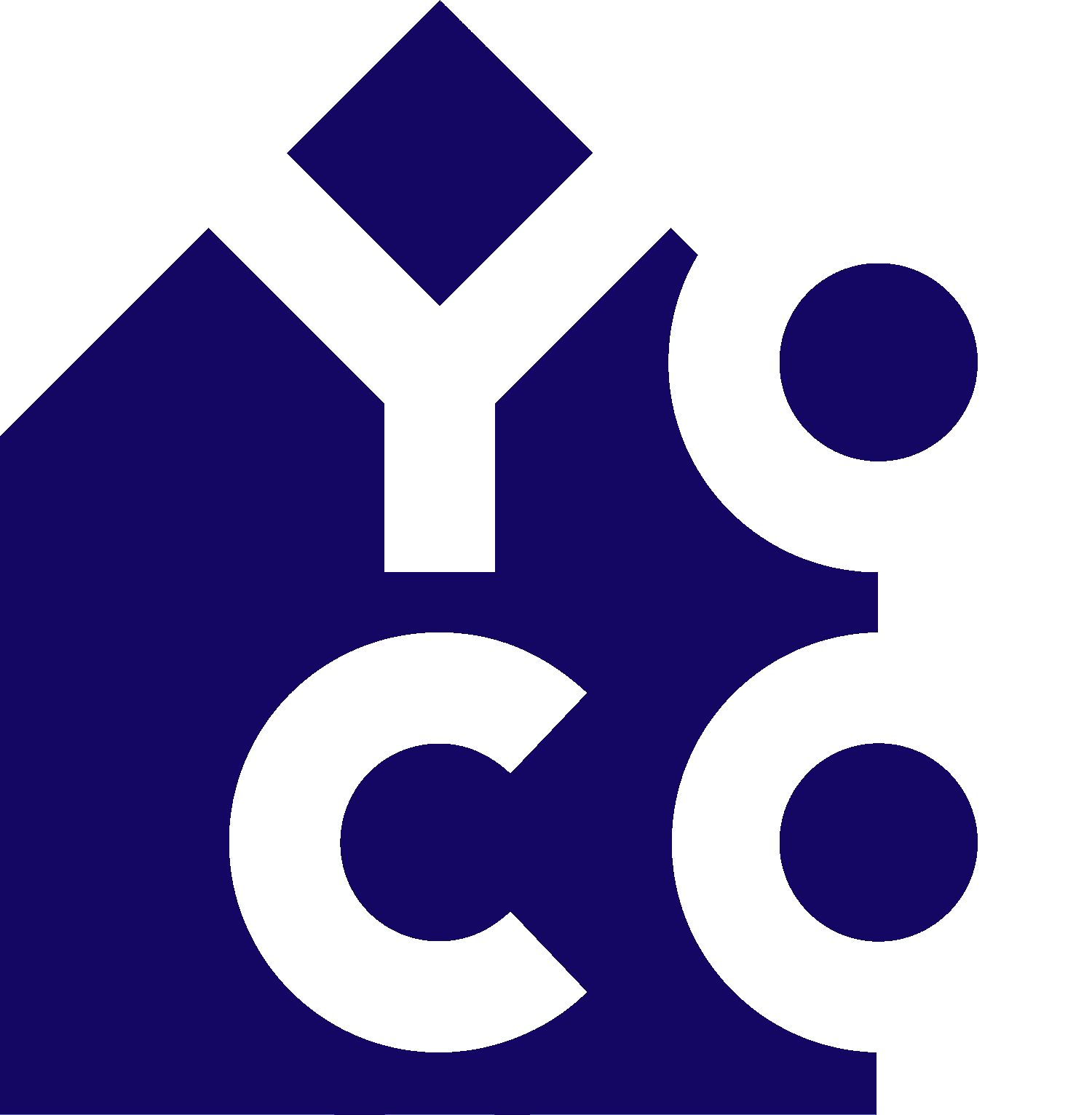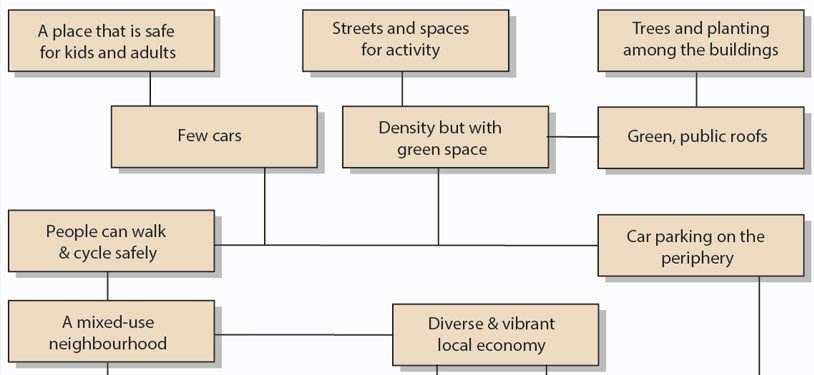YoCo’s community plan - public spaces for being collectively creative.
This blog is based on a talk Phil Bixby did at the University of York on 27th May 2022 for a symposium on Architecture, the Urban, and the Politics of Public Space
How do we think about places in a really holistic way – not simply about homes or workplaces or public space, but about how the places in which we live our lives – cities and neighbourhoods – accommodate the activities we want and provide the quality of surroundings which help make our lives rich. How broad do we need to cast our net when shaping these places? As an architect, I’ve learned that I need to go WAY beyond my profession’s traditional borders – both in who I engage with, and what I engage about. It’s not just about the buildings, nor just about the spaces, nor just about simply finding out what people want – it’s far more complex and interconnected. Recent work with YoCo has given an opportunity to really explore this.
I’ve been lucky enough to work with heritage academic Helen Graham over the past few years under the banner of My Future York – exorcising a shared frustration with York’s inability to think positively about its future. We began this through the My Castle Gateway public engagement – shaping the area around Clifford’s Tower and the Eye of York. We developed and refined an approach to public engagement which starts really early – building a brief by asking what’s important about places and what people want to do there, by then exploring the challenges rather than kicking cans down the road for the designers to somehow resolve, and ultimately making change together by building creative community networks.
Having established this approach in York, we took on building a public vision for the York Central site through My York Central, and this blog will explore how public space fits into the process of taking that public vision and turning it into a plan – working with the people of York and drawing in skills and perspectives from all quarters.
The public vision contained a number of big ideas – we condensed them to eight which included issues framed by York’s current systemic failures. People wanted forever affordable homes – places for living not investment, and they wanted streets for people – not more cars; even people who absolutely loved cars didn’t want more of them on the roads. But a number of the big ideas were around broader connected issues – people talked of moving beyond zoning to create mixed-use neighbourhoods, and about building a community made through exchange, where we addressed inequality head-on and created places where learning and skills, ideas and resources could interact to make a place where people wanted to be.
We became very aware that there were things we were unlikely to change overnight – York is the 9th most unequal city in the UK, for example. We also realised that shaping ourselves as a community group asking for permission, or seeking favours in order to duck economic reality, was not going to work. Someone commented at a workshop that “everything is economy”. We started to explore how far we needed to go in understanding local economy, and how much we could reshape it.
Through a partnership with Demos and a series of workshops last year, we worked with the My York Central vision and local creativity to explore how the elements of the vision, and the big ideas, all interconnected. We started where we wanted to be and explored how to get there. People wanted to hear birdsong outside their windows, and they wanted to see children playing in their streets. What does it take to get these?
We can take most of the cars out of the streets – moving parking to places on the periphery of neighbourhoods. That requires re-thinking the economics of car parking – deciding that car owners don’t get to use “their” streets for parking but need to cover the costs of accommodating it elsewhere. Has this been done? Yes – Vauban in Freiburg, for one example. Take away the parking from the neighbourhood and street trees become more possible – open your window and there’s more likely to be a singing bird outside it. There’s also more shade and a better environment at street level. But safe streets need to be active streets too – full of life and people who recognise each other and feel part of a neighbourhood community. That means mixing into the streetscape other uses and activities – shops and other businesses, social and cultural places, buildings and outdoor spaces where people can – to reference another of the eight big ideas – be collectively creative.
It also means thinking about density and finding ways to do it well – it becomes much easier to create a mixed-use neighbourhood if you build it in layers with different uses at ground level and above it. It makes it far easier to get around the places you need on foot or by bike. There are design challenges – how to combine privacy and openness, public and private, quiet and noise. But it also requires the right economic structures and forms of ownership. How to establish an economy which values the connections – the fact that a corner café acts as a networking point, that the wealth of older people downsizing can create places full of life and economic activity where they actually want to live. And where that intergenerational mix acknowledges what each player can bring, and what their long-term needs are.
YoCo’s community plan for York Central spells out a structure for economy and governance. This explicitly spells out the connections and states their vital role, immediately warning against fragmenting the site and simply selling it off in parcels. If you want the good stuff at the top of the structure…
…then you need to put in place the inter-relationships and economic flow which takes place in the middle of the structure…
…which itself all sits up a foundation of governance and overarching economic connection – we framed this within principles of co-ownership – where people within the community have (as far as possible) ownership and control of the spaces they use.
It highlights opportunities to work in creative ways with York’s challenges; so rather than simply attempting to ban Airbnb’s why not collectively own them, so money flows into the local community. Instead of the NRM simply pulling visitors through the surrounding streets and spaces, why not work in partnership with the community to bring to life the local railway heritage – the rich resources of lives lived working on and around the railways.
So the public spaces on York Central would in this plan be shaped by all of this context – the buildings, the economic structures, the co-ownership, the mixed community. Public spaces where friends and people who vaguely recognise each other meet and share, and where visitors are welcome guests. The bigger spaces – labelled on the masterplan as “The Great Park” – become places which are shaped to enable that collective creativity. Landscaped places where children and young people can gather and not feel excluded. Places where people can grow food, and cook and eat together, and where different generations can exchange knowledge. YoCo sees community wealth building as an essential part of a sustainable neighbourhood – and the public spaces as important parts of the structures which support it.
Let’s explore a couple of examples – projects which we’re developing at present and which the university is supporting.
The first involves thinking about how to grow your own mixed-use neighbourhood. Given forty-odd hectares of land and a small number of existing buildings – and a development programme that may likely last over 20-30yrs, “meanwhile use” becomes a consideration – how can we make use of space immediately, even if for the short term? We have experience of this in York with Spark – following the demolition of a large building on Piccadilly, a site was likely to be vacant for a period of years and so a “meanwhile use” involving shipping containers was located on it (following much outrage) which accommodated small-scale crafts, food and drink, and business start-ups. What quickly became apparent was that while the site use and activity was valuable, the opportunity to provide an environment which encouraged turning new ideas into businesses was even more so.
YoCo is clear that it wants to create a local economy – businesses which bring employment, trade, learning and skills, and culture and social life to the new neighbourhoods. We’re exploring ways in which we can create an incubator for the economic life we want to animate York Central, thinking of the sort of businesses that will support a fifteen-minute neighbourhood and also community wealth-building. The buildings (or containers) we create for this will be important, but equally important will be:-
· The economic framework – how to allow for risks and “failures” in an enduring and overall successful process, and
· The public spaces – how to bring people in, create public space which encourages participation, and also structure it in ways which deal with the conflicts inherent in urban life – privacy and engagement, noise and peace.
The second example is about bringing York’s food networks back to our doorstep, and it brings together two strands of thinking:-
· If York Central is to be a place of knowledge and learning, it needs to find equitable ways to share input from the universities, local schools, York Explore, York College and Askham Bryan, and Adult Learning and Local Area Coordination teams. We need to create places and spaces which welcome people of all ages and make valuing knowledge and learning the most natural of all things.
· Food brings people together – we’ve seen many examples of projects where food growing, cooking and eating have brough communities closer, creating understanding between cultures and demographics, and at the same time addressing issues of food quality and health.
YoCo’s aim is to create a Centre for Learning on York Central, with a focus on food. We want to work with local schools but also with further and higher education; we want to connect with York’s existing food networks – the Food Circle, Supper Collective and others – to bring people closer to the process of growing and cooking. We want to reimagine the green spaces shown on the masterplan as spaces which can be active and participatory – where food growing is a social and cultural thing, and where connections are made between “outdoors” in the city and in the countryside which surrounds it.
In both of these strands of developing ideas and YoCo’s overall community plan, public space is seen as something active, something which is part of the economic and social structures of the wider neighbourhood and city. Placemaking is about people and their broader lives. It’s about creating spaces where all of these things connect rather than simply collide, which have broad current meaning rather than just heritage or cultural significance. And essentially, where these are not simply spaces between, but spaces where important parts of people’s lives take place – much more important things than simply parking cars or enabling sufficient space to not hear a neighbour’s conversation. YoCo’s community plan is for making public spaces for being collectively creative.









